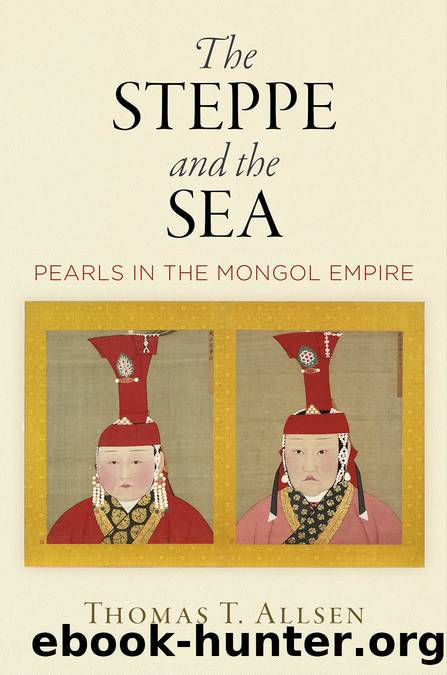The Steppe and the Sea by Thomas T. Allsen

Author:Thomas T. Allsen
Language: eng
Format: epub
Publisher: University of Pennsylvania Press, Inc.
Published: 2019-06-14T16:00:00+00:00
CHAPTER 12
By Land and by Sea
Long-distance merchants, the Polos among them, made regular use of land and sea routes, their decisions resting on a complex calculus involving weather, war, commercial possibilities, and government policies. And except for winds and weather, the other factors were always negotiable or potentially avoidable. So, for example, notwithstanding the traditional Chinese insistence that all individuals and missions must return home by their port of entry, whether inland or coastal, merchants managed to avoid such stipulations, selecting exit routes best suited to their immediate needs.1 In this they were certainly aided by official corruption, but perhaps the more important ingredient in their success was the availability of up-to-date intelligence provided by ad hoc individualized news networks and by commercial postal agencies that moved information at rates of speed bureaucratic communication systems could not match.2
But, despite merchants’ common use of both options, the relationship between maritime and overland trade has yet to receive the attention it deserves, a deficit attributable to several factors. Most important, there is a tendency to divorce the steppe from the sea. The general assumption that influences from the southern oceans did not reach Inner Asia is true for climatic forces, but not for commercial and cultural interactions.3 The other and related difficulty is attributable to traditional academic divisions of labor in which steppe and maritime history are considered separate fields.
I do not mean to imply that no attention has been paid to their manifold interconnections; I mean rather that the number of studies devoted to overland or to maritime trade individually dwarfs that focused on their conjunctions. In recent decades quality studies on their interconnections that address a number of interrelated problems have appeared: the origins and destinations of natural products and finished goods entering and leaving maritime trade; the question of whether the volume of maritime and overland trade rises and falls in tandem or independently of each other; and the importance of exploring the multiple linkages between the regional economies of Eurasia, rather than simply comparing the structural characteristics of the European economy with that of Asia, comparisons that are often presented in a static, unduly homogenized fashion.4 Among many other benefits, the further consideration of the patterns of intra-Asian trade will help identify the basic building blocks that enabled the Mongols to fashion a transcontinental network embracing both land and sea.
Without demonstrating and documenting these conjunctions in detail, the validity, nature, and dynamics of world systems, or at least Old World systems, cannot be determined. In pursuit of this goal, one of the basic issues is that of data and source material. There is, to begin with, a considerable body of information that directly documents the crucial connections between the two systems of transport. We know from literary and archaeological evidence that throughout the Middle Ages the major entrepôts of the Persian Gulf—Sīrāf, Kīsh, and Hormuz—were connected to the larger cities of Iran, Iraq, and the Levant by caravan routes, some of which were developed and funded by merchant princes with extensive maritime interests and commitments.
Download
This site does not store any files on its server. We only index and link to content provided by other sites. Please contact the content providers to delete copyright contents if any and email us, we'll remove relevant links or contents immediately.
| Beadwork | Jewelry |
| Rock & Gem Crafts |
On Writing A Memoir of the Craft by Stephen King(4892)
The Doodle Revolution by Sunni Brown(4713)
A Simplified Life by Emily Ley(4129)
Mummy Knew by Lisa James(3655)
Marijuana Grower's Handbook by Ed Rosenthal(3643)
Better Homes and Gardens New Cookbook by Better Homes & Gardens(3547)
Figure Drawing for Artists by Steve Huston(3409)
Paper Parties by Erin Hung(3398)
Draw Your Day by Samantha Dion Baker(3318)
The Genius of Japanese Carpentry by Azby Brown(3254)
Japanese Design by Patricia J. Graham(3138)
The Code Book by Simon Singh(3138)
Dangerous Girls by Haas Abigail(2994)
Lions and Lace by Meagan Mckinney(2941)
The Curated Closet by Anuschka Rees(2940)
How to Make Your Own Soap by Sally Hornsey(2866)
The Checklist Manifesto by Atul Gawande(2810)
The Wardrobe Wakeup by Lois Joy Johnson(2754)
Zero to Make by David Lang(2753)
